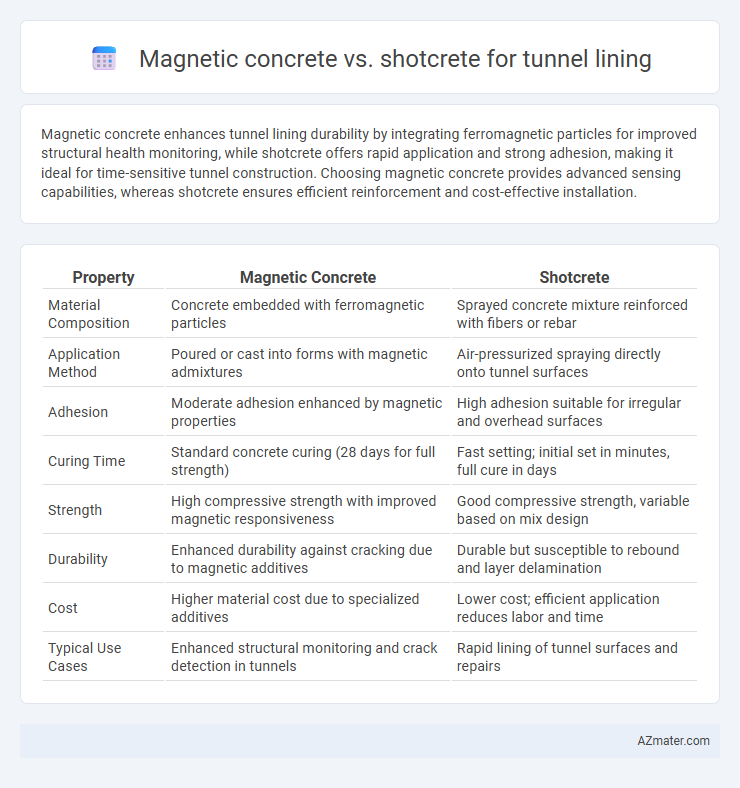Magnetic concrete enhances tunnel lining durability by integrating ferromagnetic particles for improved structural health monitoring, while shotcrete offers rapid application and strong adhesion, making it ideal for time-sensitive tunnel construction. Choosing magnetic concrete provides advanced sensing capabilities, whereas shotcrete ensures efficient reinforcement and cost-effective installation.
Table of Comparison
| Property | Magnetic Concrete | Shotcrete |
|---|---|---|
| Material Composition | Concrete embedded with ferromagnetic particles | Sprayed concrete mixture reinforced with fibers or rebar |
| Application Method | Poured or cast into forms with magnetic admixtures | Air-pressurized spraying directly onto tunnel surfaces |
| Adhesion | Moderate adhesion enhanced by magnetic properties | High adhesion suitable for irregular and overhead surfaces |
| Curing Time | Standard concrete curing (28 days for full strength) | Fast setting; initial set in minutes, full cure in days |
| Strength | High compressive strength with improved magnetic responsiveness | Good compressive strength, variable based on mix design |
| Durability | Enhanced durability against cracking due to magnetic additives | Durable but susceptible to rebound and layer delamination |
| Cost | Higher material cost due to specialized additives | Lower cost; efficient application reduces labor and time |
| Typical Use Cases | Enhanced structural monitoring and crack detection in tunnels | Rapid lining of tunnel surfaces and repairs |
Introduction to Tunnel Lining Materials
Magnetic concrete and shotcrete are advanced materials used in tunnel lining to enhance structural integrity and durability. Shotcrete, a sprayed concrete mix, offers rapid application and high adhesion to tunnel surfaces, making it suitable for irregular shapes and quick reinforcement. Magnetic concrete integrates magnetic particles to enable real-time monitoring of stress and deformation, providing innovative solutions for tunnel safety and maintenance.
Overview of Magnetic Concrete
Magnetic concrete incorporates ferromagnetic materials such as magnetite or steel fibers, enhancing electromagnetic properties for tunnel lining applications. This innovative lining solution improves structural health monitoring through real-time magnetic field sensing, enabling early detection of cracks or deformations. Magnetic concrete also offers enhanced durability and resistance to mechanical stress compared to traditional tunnel lining materials.
Understanding Shotcrete in Tunnel Applications
Shotcrete in tunnel lining offers rapid application and excellent adhesion to complex surfaces, making it ideal for stabilizing excavation walls. Its hydraulic setting properties allow early strength development, crucial for maintaining tunnel integrity under varying geological conditions. Magnetic concrete, while innovative in self-monitoring capabilities, lacks the immediate versatility and adaptability that shotcrete provides in dynamic tunnel construction environments.
Key Performance Differences
Magnetic concrete offers enhanced electromagnetic interference shielding and improved durability compared to shotcrete, which provides faster application and better adhesion for tunnel lining. Shotcrete excels in flexibility and rapid setting times, ideal for complex geometries and immediate structural support. Magnetic concrete's denser matrix contributes to superior long-term structural integrity, while shotcrete maintains cost-effectiveness and ease of repair.
Installation Techniques Compared
Magnetic concrete utilizes electromagnetic alignment for precise particle orientation during installation, enhancing structural integrity and reducing curing time. Shotcrete is applied through a high-velocity spraying process that enables rapid layer buildup and excellent adherence to irregular tunnel surfaces. Magnetic concrete's technology-driven installation demands specialized equipment, whereas shotcrete offers greater flexibility and speed in diverse tunnel environments.
Durability and Longevity
Magnetic concrete enhances tunnel lining durability by improving crack resistance through embedded electromagnetic properties that actively monitor structural integrity, while shotcrete offers rapid application and strong initial adhesion but may suffer from shrinkage and susceptibility to environmental degradation over time. The longevity of magnetic concrete in tunnel linings benefits from its self-sensing capability, enabling early detection of weaknesses and reducing maintenance frequency, whereas shotcrete requires more frequent inspections and repairs due to potential material wear and reduced durability under sustained stress conditions. Selecting magnetic concrete over shotcrete results in improved lifecycle performance and lower total ownership costs, especially in tunnels exposed to aggressive geological and climatic conditions.
Cost Analysis and Budget Considerations
Magnetic concrete for tunnel lining offers higher initial material costs compared to shotcrete, but its enhanced durability and reduced maintenance expenses can lead to long-term savings. Shotcrete, favored for its rapid application and lower upfront price, may incur higher refurbishment and reinforcement costs over the tunnel's lifespan. Budget considerations must weigh the trade-off between magnetic concrete's premium investment and shotcrete's frequent repair needs to determine the most cost-effective solution for specific tunnel projects.
Environmental Impact and Sustainability
Magnetic concrete for tunnel lining offers enhanced durability and reduced maintenance, which leads to lower resource consumption and greenhouse gas emissions over the tunnel's lifecycle compared to traditional shotcrete. Shotcrete, while widely used due to its ease of application, often requires more frequent repairs and material input, increasing its environmental footprint through higher cement production and waste generation. Incorporating magnetic concrete contributes to sustainable construction practices by extending service life and improving energy efficiency in underground infrastructure projects.
Safety and Maintenance Requirements
Magnetic concrete incorporates ferromagnetic materials that enhance crack detection and structural monitoring, improving safety by allowing early identification of potential failures in tunnel lining. Shotcrete, a sprayed concrete, provides rapid application and strong adhesion but requires regular inspections to address potential delamination and surface wear issues. Maintenance for magnetic concrete focuses on sensor calibration and data interpretation, whereas shotcrete demands frequent visual assessments and repair of surface degradation to ensure long-term tunnel integrity.
Best Use Cases: Magnetic Concrete vs Shotcrete
Magnetic concrete excels in tunnel lining projects requiring enhanced structural monitoring and electromagnetic shielding, making it ideal for tunnels near sensitive communication infrastructure. Shotcrete offers rapid application and adaptability to complex tunnel geometries, proving best for emergency repairs and irregular tunnel profiles. Both materials optimize tunnel safety, but magnetic concrete is preferred for long-term performance and monitoring, while shotcrete suits scenarios demanding quick installation and flexibility.

Infographic: Magnetic concrete vs Shotcrete for Tunnel lining
 azmater.com
azmater.com